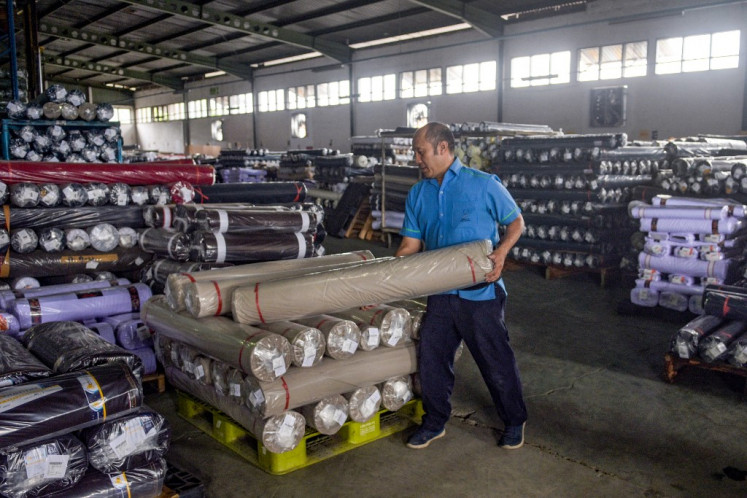Popular Reads
Top Results
Can't find what you're looking for?
View all search resultsPopular Reads
Top Results
Can't find what you're looking for?
View all search resultsAnalysis: More incentives needed to boost electronics industry
Rising demand is expected to have seen consumer electronics sales in Indonesia reach Rp 28 trillion (US$3
Change text size
Gift Premium Articles
to Anyone
R
ising demand is expected to have seen consumer electronics sales in Indonesia reach Rp 28 trillion (US$3.1 bilion) in 2011, according to the country’s producers association. While the figure underlines healthy growth in the sector, industry leaders say improved incentives and better infrastructure could lead to faster progress.
The estimate from the Electronic Producers Association (Gabel), given late last year, is a 7.25 percent rise in its initial predictions for sales in 2011 that it says is due to increased consumer interest. Sales of electronics, including television sets, refrigerators and washing machines, were valued at Rp 21.6 trillion ($2.4 billion) in the first nine months of 2011, Gabel’s chairman Ali Soebroto Oentaryo told local media.
While domestic demand is rising amid strong buyer sentiment — government figures show that consumer confidence improved to 110.24 in the third quarter of 2011 from 106.36 in the second quarter of 2011 — the country is also making progress towards its ambitions to become a regional manufacturing hub.
Indonesia is already home to plants run by Panasonic, Sanyo, Epson, Sharp and LG, with producers citing the country’s competitive labor costs and conditions, as well as the business environment, as good reasons for doing business in the country. LG and Samsung have also established research and development facilities and compete for human resource talent by working with universities and recruitment firms.
However, while market analysis firm Research and Markets predicts the consumer electronics market will be worth $11.6 billion by 2014, players in the sector cite a need for added government incentives and improved infrastructure, with major South Korean and Japanese firms interested in investing in the latter’s development through renewable energy.
Sharp announced a $1 billion plan in November to study solar power projects, following similar $200 million plans announced by Samsung in April to spend on developing solar power. The renewable energy plans comes as electronics firms are showing increased interest in tapping into growth in remote areas driven by thriving industries such as crude palm oil production and mining.
Indeed, the country has huge potential but is hampered by a lack of infrastructure, Kim Weon Dae, the president-director of LG Electronics Indonesia, told OBG. “Infrastructure needs to speed up. Good governance and law enforcement are also necessary to see more investment in the country,” he said.
“We want to meet with the government to discuss our concerns regarding the insufficient social infrastructure in Indonesia and develop a long-term plan for infrastructure as this problem is driving up our costs and bringing our competitiveness down,” Man Gyu Yim, the president-director of Samsung Electronics Indonesia, told OBG.
The major earthquake and tsunami in Japan, along with flooding in Thailand, could also exacerbate supply problems related to the domestic industry’s dependence on imported parts, the level of which rose 11 percent in the first 10 months of 2011.
One factor likely to affect the supply of parts is the ASEAN-China Free Trade Agreement (ACFTA), which came into effect on Jan. 1, 2010. This is likely to see prices fall in future. However, the agreement has also brought more competitors to the market.
“This is affecting specially the IT and mobile market, and not the TV/cinema/video market,” said Kim.
“In the consumer electronics category there is a lot of marketing, logistics, investment, and so on. [Chinese firms] still don’t represent an alternative. Our image is very strong and the gap between our company and Chinese companies is still really big.”
As the global and domestic market becomes more competitive, industry leaders say it is time for Jakarta to lend more support to the industry.
“There is sometimes a certain complacence on the part of the investment authorities in Indonesia because of their vast natural resources,” said Man. “We would like them to put in place more incentives, particularly in R&D and electronics manufacturing, to add value to Indonesia’s mineral wealth.”
The demand for innovative products by Indonesia’s growing middle class — GDP surpassed $3000 per capita for the first time last year — is reflected in surging sales of smartphones and tablet computers.
Smartphone penetration was 38 percent in November 2011, with this expected to reach 67 percent
by mid-2012, according to Nielsen Indonesia Research. The International Data Corporation, meanwhile, estimated that in the January-July 2011 period alone, 2.6m smart phones were shipped in Indonesia, 13.8 percent of all mobile phone sales in the country.










